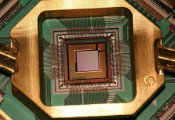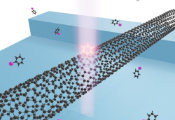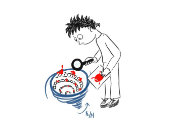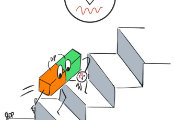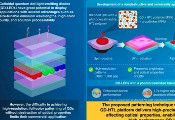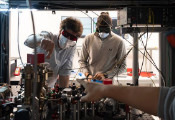Quantum Researchers Observe Real-Time Switching of the Magnet in the Heart of a Single Atom
August 28, 2025 -- Researchers from Delft University of Technology in The Netherlands have been able to see the magnetic nucleus of an atom switch back and forth in real time. They read out the nuclear ‘spin’ via the electrons in the same atom through the needle of a scanning tunneling microscope. To their surprise, the spin remained stable for several seconds, offering prospects for enhanced control of the magnetic nucleus. The research, published in Nature Communications, is a step forward for quantum sensing at the atomic scale.
A scanning tunneling microscope (STM) consists of an atomically-sharp needle that can ‘feel’ single atoms on a surface and make images with atomic resolution. Or to be precise, STM can only feel the electrons that surround the atomic nucleus. Both the electrons and the nucleus in an atom are potentially small magnets. Depending on the type of atom, they each carry a quantity called ‘spin’, the quantum-mechanical equivalent of magnetism. Measuring the motion of an individual electron spin with an STM was achieved for the first time a decade ago. The TU Delft research group led by professor Sander Otte wanted to know: could they also use an STM to read out the nuclear spin in time, the other part of the atom?
Reading out the nuclear spin
The STM is not sensitive to nuclear spins directly, so the team had to use the electron to read out the nuclear spin indirectly. “The general idea had been demonstrated a few years ago, making use of the so-called hyperfine interaction between electron and nuclear spins”, Otte explains. "However, these early measurements were too slow to capture the motion of the nuclear spin over time.”
Rapid measurements
First authors Evert Stolte and Jinwon Lee set out to perform rapid measurements on an atom known to carry a nuclear spin. To their excitement, they observed the signal switching between two distinct levels in real time, live on their computer screen. “We were able to show that this switching corresponds to the nuclear spin flipping from one quantum state to another, and back again”, Stolte says. They determined that it takes about five seconds before the spin changes, much longer than many other quantum systems available for the STM. For instance, the lifetime of the electron spin in the same atom is only around 100 nanoseconds.
Single-shot readout
Since the researchers could measure nuclear spin state faster than it flips and (mostly) without causing a flip by the measurement itself, they achieved so-called ‘single-shot readout’. This opens up exciting experimental possibilities for controlling the nuclear spin. Furthermore, fundamental progress in the readout and control of an on-surface nuclear spins could, in the long term, assist in applications like quantum simulation or quantum sensing at the atomic scale. Stolte: “The first step in any new experimental frontier is being able to measure it, and that is what we were able to do for nuclear spins at the atomic scale.”

